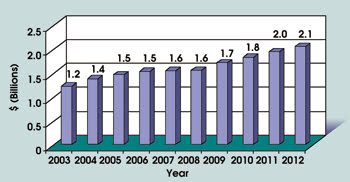Study shows that the US machine vision industry will return to strength.
Paul Kellett, Automated Imaging Association
If you produce it, will customers buy it? As with other firms, machine vision companies are wondering how the products they manufacture will sell in the current economy. The concern is well justified; although machine vision products historically have sold quite well over the long term, economic downturns have taken their toll in the short term. The last recession in the US, which occurred in 2001, hit machine vision sales quite hard. Will that happen again?

The long-term trend in machine vision sales is decidedly positive.
To answer this question, the Automated Imaging Association’s (AIA) machine vision market study released in March, “Machine Vision Markets: 2007 Results and Forecasts to 2012,” focused heavily on the role of the economy. The study found that, although the economy will depress sales growth in the short term, the long-term prospects of the machine vision industry remain solid. For this reason, it is important for machine vision companies to maintain a balanced perspective. They should avoid both a “gloom and doom” outlook based on an assumed continuation of short-term sales weakness and an overexuberance about the long-term growth potential of machine vision product markets.
As evidence of long-term growth, the new study found that, over machine vision’s relatively brief history, it has made major inroads in manufacturing and in other sectors of the economy. From its humble roots approximately 25 years ago, it has evolved into an important automation technology, having assumed an indispensable role as an enabler of quality control, productivity and cost containment in a growing number of industries.
In North America alone, sales volumes for machine vision components reached $205.8 million in 2007. In that same year, machine vision systems — including smart cameras — achieved sales of $1349.7 million. All in all, financial transactions involving machine vision products in North America totaled $1.6 billion in 2007 and are estimated to hit the $2.1 billion mark by 2012 (see figure). Clearly, machine vision is a growth industry in North America.
However, as previously mentioned, the impressive growth of the industry has not meant immunity to the vagaries of the economy. The 2001 US recession sharply depressed sales; some machine vision product markets took several years before their rates of growth turned positive — but turn positive, they did. Tapping into pent-up demand, those markets experienced a sharp recovery, which continued unabated through 2006.
In 2007, however, sales growth hit a brick wall once again, reflecting a general cooling of the US economy. What will happen in 2008? Based on economic projections, the AIA has forecast that the slowdown experienced in 2007 will intensify in 2008, regardless of whether US and Canadian economies fall into outright recession.
Capital expenditures
How does a weak economy affect machine vision sales? The role of capital expenditures provides an important insight. In an immediate sense, capital expenditure funding enables the purchase of machine vision products. The higher the capital expenditure funding, the more money can be spent on machine vision products (all things being equal), and vice versa. This relationship reflects the fact that, when businesses experience or foresee weak earnings growth, they cut back outlays, including hiring and capital expenditures, to maintain solvency. Indeed, the fiduciary responsibility of chief financial officers requires them to manage capital expenditures very carefully. As a consequence, recessions and slowdowns — and the periods preceding them — make it more likely that little or no growth in machine vision sales volumes will occur.
However, this is not to suggest that the relationship between the economy and machine vision sales volumes is simple. To the contrary, it is quite complex. For example, changes in machine vision sales volumes can lag behind the economy or lead it as businesses react to fears of earnings declines in advance of their occurrence or as they wait until production ramps up to threshold levels where sufficient internal capital is generated for discretionary capital expenditures. Also, various machine vision product markets can be affected differently by different sectors of the economy, which tend to exhibit dissimilar rates of growth.
Regardless of the extent to which sales volumes fall off, the essential role of machine vision will remain unchanged. It still will represent a key enabler of cost containment, productivity and quality control in production, and it is this important role, which only machine vision technology can play, that accounts for its past and future upward trend in sales.
For this reason, and based on the historical performance of machine vision markets throughout the last business cycle, AIA expects sales to rebound sharply after the current period of economic weakness.
Meet the author
Paul Kellett is director of market analysis with the Automated Imaging Association in Ann Arbor, Mich.; e-mail: pkel [email protected].